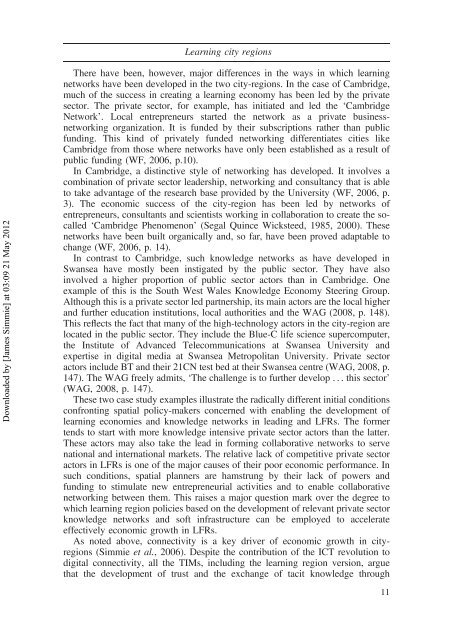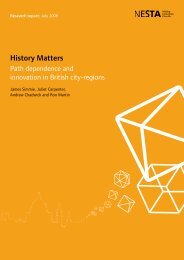Theory and Practice in Private and Public Sector Spatial Planning
Theory and Practice in Private and Public Sector Spatial Planning
Theory and Practice in Private and Public Sector Spatial Planning
- No tags were found...
You also want an ePaper? Increase the reach of your titles
YUMPU automatically turns print PDFs into web optimized ePapers that Google loves.
Learn<strong>in</strong>g city regionsDownloaded by [James Simmie] at 03:09 21 May 2012There have been, however, major differences <strong>in</strong> the ways <strong>in</strong> which learn<strong>in</strong>gnetworks have been developed <strong>in</strong> the two city-regions. In the case of Cambridge,much of the success <strong>in</strong> creat<strong>in</strong>g a learn<strong>in</strong>g economy has been led by the privatesector. The private sector, for example, has <strong>in</strong>itiated <strong>and</strong> led the ‘CambridgeNetwork’. Local entrepreneurs started the network as a private bus<strong>in</strong>essnetwork<strong>in</strong>gorganization. It is funded by their subscriptions rather than publicfund<strong>in</strong>g. This k<strong>in</strong>d of privately funded network<strong>in</strong>g differentiates cities likeCambridge from those where networks have only been established as a result ofpublic fund<strong>in</strong>g (WF, 2006, p.10).In Cambridge, a dist<strong>in</strong>ctive style of network<strong>in</strong>g has developed. It <strong>in</strong>volves acomb<strong>in</strong>ation of private sector leadership, network<strong>in</strong>g <strong>and</strong> consultancy that is ableto take advantage of the research base provided by the University (WF, 2006, p.3). The economic success of the city-region has been led by networks ofentrepreneurs, consultants <strong>and</strong> scientists work<strong>in</strong>g <strong>in</strong> collaboration to create the socalled‘Cambridge Phenomenon’ (Segal Qu<strong>in</strong>ce Wicksteed, 1985, 2000). Thesenetworks have been built organically <strong>and</strong>, so far, have been proved adaptable tochange (WF, 2006, p. 14).In contrast to Cambridge, such knowledge networks as have developed <strong>in</strong>Swansea have mostly been <strong>in</strong>stigated by the public sector. They have also<strong>in</strong>volved a higher proportion of public sector actors than <strong>in</strong> Cambridge. Oneexample of this is the South West Wales Knowledge Economy Steer<strong>in</strong>g Group.Although this is a private sector led partnership, its ma<strong>in</strong> actors are the local higher<strong>and</strong> further education <strong>in</strong>stitutions, local authorities <strong>and</strong> the WAG (2008, p. 148).This reflects the fact that many of the high-technology actors <strong>in</strong> the city-region arelocated <strong>in</strong> the public sector. They <strong>in</strong>clude the Blue-C life science supercomputer,the Institute of Advanced Telecommunications at Swansea University <strong>and</strong>expertise <strong>in</strong> digital media at Swansea Metropolitan University. <strong>Private</strong> sectoractors <strong>in</strong>clude BT <strong>and</strong> their 21CN test bed at their Swansea centre (WAG, 2008, p.147). The WAG freely admits, ‘The challenge is to further develop . . . this sector’(WAG, 2008, p. 147).These two case study examples illustrate the radically different <strong>in</strong>itial conditionsconfront<strong>in</strong>g spatial policy-makers concerned with enabl<strong>in</strong>g the development oflearn<strong>in</strong>g economies <strong>and</strong> knowledge networks <strong>in</strong> lead<strong>in</strong>g <strong>and</strong> LFRs. The formertends to start with more knowledge <strong>in</strong>tensive private sector actors than the latter.These actors may also take the lead <strong>in</strong> form<strong>in</strong>g collaborative networks to servenational <strong>and</strong> <strong>in</strong>ternational markets. The relative lack of competitive private sectoractors <strong>in</strong> LFRs is one of the major causes of their poor economic performance. Insuch conditions, spatial planners are hamstrung by their lack of powers <strong>and</strong>fund<strong>in</strong>g to stimulate new entrepreneurial activities <strong>and</strong> to enable collaborativenetwork<strong>in</strong>g between them. This raises a major question mark over the degree towhich learn<strong>in</strong>g region policies based on the development of relevant private sectorknowledge networks <strong>and</strong> soft <strong>in</strong>frastructure can be employed to accelerateeffectively economic growth <strong>in</strong> LFRs.As noted above, connectivity is a key driver of economic growth <strong>in</strong> cityregions(Simmie et al., 2006). Despite the contribution of the ICT revolution todigital connectivity, all the TIMs, <strong>in</strong>clud<strong>in</strong>g the learn<strong>in</strong>g region version, arguethat the development of trust <strong>and</strong> the exchange of tacit knowledge through11













